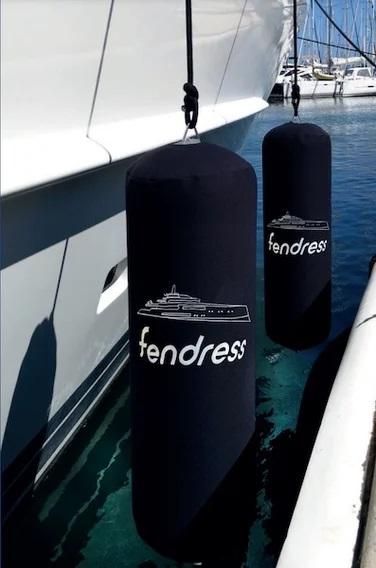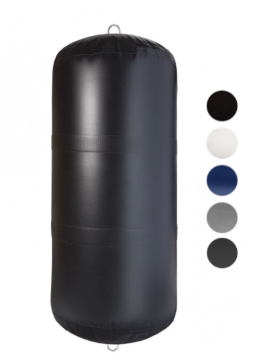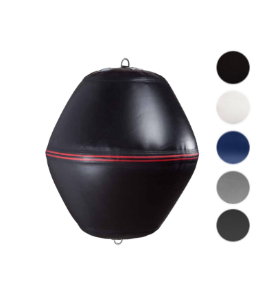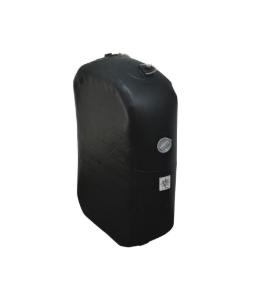When it comes to protecting topsides, hulls, and gelcoat during berthing or rafting up, fenders are your first line of defence. While traditional solid rubber or foam-filled fenders have long been the default, there is a growing shift towards inflatable fenders — particularly among larger yachts and technically minded owners looking for weight savings, storage flexibility, and ease of deployment.
This article explores why inflatable fenders are becoming increasingly popular, the technical differences in their construction and materials, and the formats available on the market today.
Why Choose Inflatable Fenders?
Significant Weight Savings
Traditional rubber or PVC fenders can be heavy, especially in the larger diameters needed for boats above 40ft. Inflatable fenders, by contrast, are typically constructed from high-strength fabric-reinforced materials such as PVC or TPU. Even in large sizes, they weigh a fraction of their solid counterparts — often 60–80% less — which has a direct benefit on boat performance, crew fatigue, and even trim on weight-sensitive performance yachts.
Compact Storage
One of the most practical advantages is how little space inflatable fenders occupy when deflated. For cruising yachts short on storage, or offshore racers looking to reduce deck clutter, the ability to stow multiple large fenders in a locker, sail bag or lazarette is a game changer.
Easy Handling and Deployment
Inflatable fenders can be rapidly inflated using a manual or electric pump and stowed again just as quickly. For shorthanded crews or less physically able sailors, this ease of handling is a major upgrade over manhandling oversized rubber fenders.
Superior Shock Absorption
Inflatable fenders can be tuned by adjusting air pressure to suit the specific conditions — allowing for a more gradual energy transfer under load. This can reduce peak forces on stanchions, toe rails or guardrails in swell or surge-prone berths, or when rafting up with other vessels of unequal freeboard.
Fendress Inflatable Fenders
Construction and Material Choices: What Sets Inflatable Fenders Apart
When evaluating inflatable fenders, it’s important to look at both how they’re constructed and what they’re made from. These two factors determine durability, pressure capability, long-term air retention, and resistance to marine degradation.
Seam Construction: Glued vs Welded
Glued Seams
This method uses solvent-based adhesives to bond the seams of fabric panels — most often with PVC or TPU coatings. It allows for flexible shaping and lower manufacturing cost. However, glued seams are more prone to degradation from UV, heat, and salt over time. For leisure marine use, glued fenders are a cost-effective choice, but they are less reliable in demanding long-term commercial applications.
Welded Seams
Welded seams — created via heat or RF welding — offer superior mechanical strength and air-tightness. Welded construction is more consistent and reliable, making it the preferred method for commercial and superyacht-grade inflatable fenders. These products typically support higher inflation pressures, improving both fender rigidity and energy absorption.
Material Choices: PVC, TPU, Hypalon, and Reinforced Laminates
PVC (Polyvinyl Chloride)
The most common material for budget and mid-range fenders. It’s easy to process, relatively inexpensive, and offers reasonable durability. However, PVC has limited UV resistance and can become brittle over time. Best suited for short-haul cruising and casual use where cost and portability are the main concerns.
TPU (Thermoplastic Polyurethane)
TPU is a more advanced material offering high elasticity, chemical stability, and abrasion resistance. It remains flexible over a wider temperature range and offers excellent resistance to fatigue and puncture. Welded TPU fenders are commonly found in high-end recreational or performance yachts, and often carry higher inflation ratings.
Hypalon (CSM – Chlorosulfonated Polyethylene)
Historically used in premium inflatables and some fender designs, Hypalon is extremely resistant to UV, ozone, and environmental degradation. While it is heavier and more expensive than PVC or TPU, it offers exceptional long-term performance and ease of patching. Although no longer produced under the Hypalon brand name, CSM-based fabrics are still available and may appear in high-spec fenders.
Fabric Reinforcements
The core strength of an inflatable fender often lies in its reinforcement layer — usually a woven nylon or polyester fabric laminated with the outer coating. Higher-end products may use double-wall fabrics or specialised multi-axial weaves to resist tearing and maintain shape under high pressure.
Material | Strengths | Weaknesses | Best For |
PVC | Low cost, easy to glue | UV sensitivity, short lifespan | Leisure marine default choice |
TPU | Weldable, strong, UV stable | Higher cost | Performance and Superyachts |
Hypalon (CSM) | Very durable, UV/ozone resistant | Heavy, costly | Superyachts, long-term commercial use |
Reinforced Laminates | High tensile strength, shape retention | Depends on base polymer | All higher-end fenders |
Boat Fender Formats: Cylindrical, Ball, and Flat
Inflatable fenders come in a variety of shapes tailored for different berthing situations:
Cylindrical Fenders: The most versatile option. Can be deployed vertically or horizontally and are suitable for both side-to berths and raft-ups.
Cylindrical Fendress Inflatable Fender
Ball or Round Fenders: Effective at absorbing high point loads, often used at the bow or stern and as a floating option during manouvres.
Round Fendress Inflatable Fender
Flat Fenders: Growing in popularity thanks to their ease of storage and large surface area. Some use hybrid foam-inflatable construction to provide both cushioning and resistance to rolling.
Flat Fendress Inflatable Fender
Are Inflatable Fenders Right for You?
If you’re operating from a fixed berth and storage isn’t an issue, traditional rubber fenders may still serve you well. But for modern cruisers, offshore passage-makers and performance-focused sailors, inflatable fenders deliver a compelling mix of protection, portability, and reduced topside weight.
They’re also excellent as backup fenders — ideal for unplanned raft-ups, visiting unfamiliar harbours, or protecting against pilings and awkward dock geometries.
At Upffront, we currently stock a range of Fendress inflatable fenders — a respected European manufacturer known for practical, lightweight designs and reliable seam construction.
We are actively expanding this category due to increasing customer demand. If you are interested in other brands or have a specific product in mind, we’d be happy to source it for you.
📩 Contact us via our enquiry page for tailored advice or a personalised quote or click below to see our full range:






Inflatable Fenders: Lightweight Protection for Serious Sailors